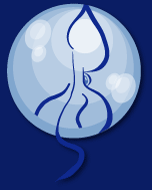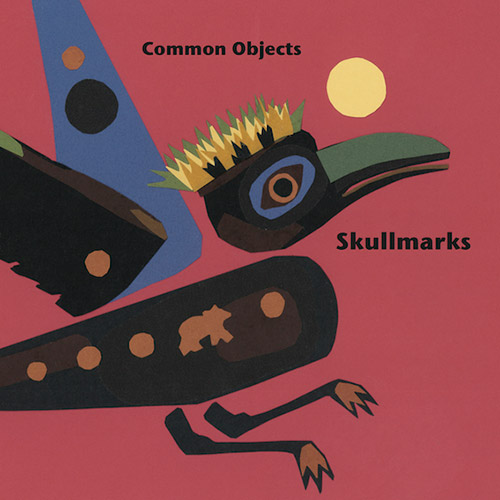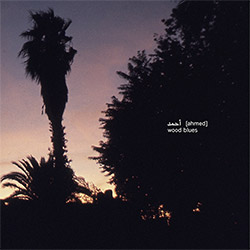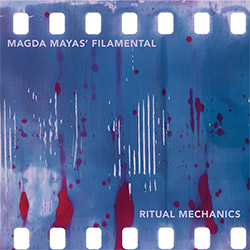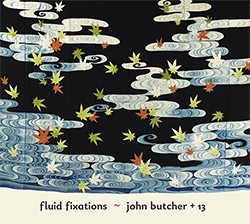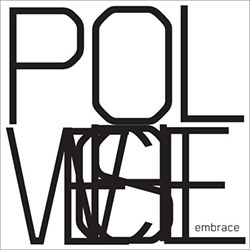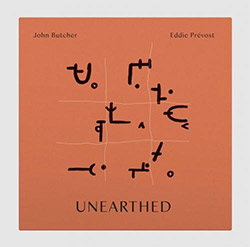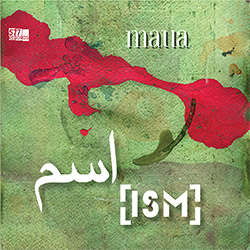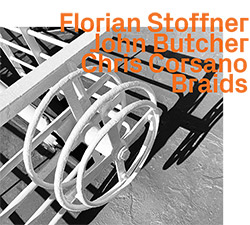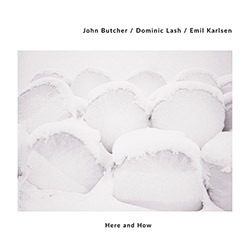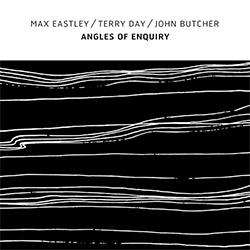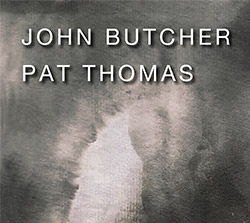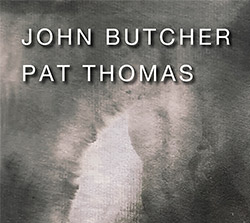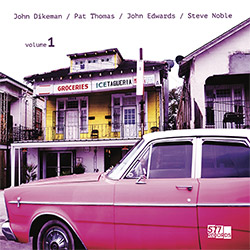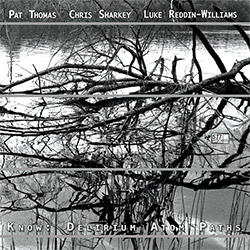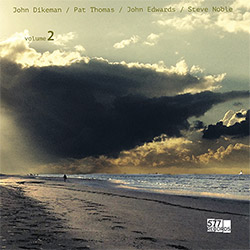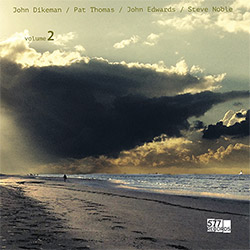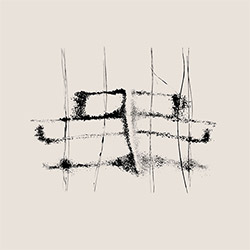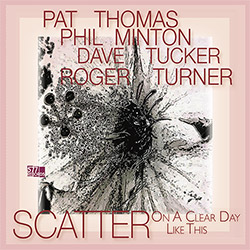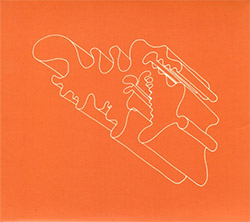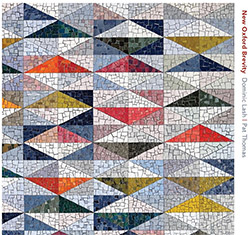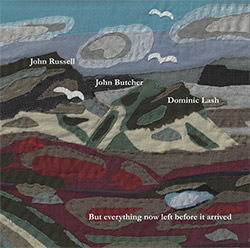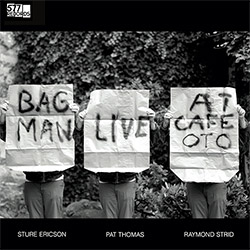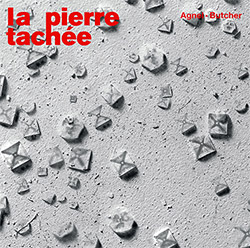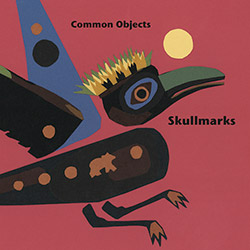
Distributing the group--John Butcher, Angharad Davies, Lina Lapelyte, Lee Patterson, Pat Thomas, and Rhodri Davies--inside the Pitt Rivers Museum in Oxford, Butcher chose 4 shamanic objects from the museum's ethnographic collection, evoking water, air, earth, spirit, ritual and utility, used as a score orchestrating varying combinations of players; intense and profound improvisation.
Save $1.70
In Stock
Quantity in Basket: None
Log In to use our Wish List
Shipping Weight: 2.00 units
Sample The Album:
John Butcher-soprano saxophone, tenor saxophone
Angharad Davies-violin
Rhodri Davies-electric harp
Lina Lapelyte-violin
Lee Patterson-amplified devices and processes
Pat Thomas-electronics
Click an artist name above to see in-stock items for that artist.
Includes liner notes by Rhodri Davies and John Butcher in English and Japanese (translation by Megumi Sakata)
Label: Meenna
Catalog ID: meenna-980
Squidco Product Code: 26633
Format: CD
Condition: New
Released: 2018
Country: Japan
Packaging: Cardboard Gatefold
Recorded at the Pitt Rivers Museum, in Oxford, UK, on March 22nd, 2016, by Simon Reynell.
"The group Common Objects was formed in 2005 by the British harpist/composer Rhodri Davies. The group has had a fluid membership, but in recent years its core members have been the six musicians performing on this album: John Butcher, Angharad Davies, Lina Lapelyte, Lee Patterson, Pat Thomas, and Rhodri Davies. Common Objects performs a wide range of music, from composed works to improvisation. Skullmarks documents the group's first project in which objects are used as scores.
In 2016 Common Objects selected three museums as performance venues and carried out a mini-tour called "Sonorous Matter." Each of the six musicians had chosen items from among the museums' collections as the basis of a score to be performed by the group. "Skullmarks," the work recorded on this album, was based on four historical objects that John Butcher selected from the huge ethnographic collection at the Pitt Rivers Museum in Oxford. These objects were displayed to the musicians and audience during the performance held at the museum on March 22, 2016. The concert, which had a strange and mysterious mood due to the shamanic objects and the atmosphere of the museum at night, resulted in a superb performance with a rare aura and energy."-from the liner notes
"Skullmarks was performed by Common Objects in 2016 inside the cavernous Pitt Rivers Museum, home to a mysterious ethnographic collection of over half a million items.I chose these four objects to display to the musicians and the audience, setting a special focus and atmosphere for the music. They are made of wood, bone and clay, evoking consideration of water, air, earth, spirit, ritual and utility.The score orchestrated different combinations of the players, distributed inside the very large central space and the upper galleries. The Museum building itself should be thought of as a fifth object, intrinsically evocative and enabling rich sonic perspectives - from acoustic sounds in extreme resonance to hermetic electronics."-John Butcher
"I formed Common Objects in 2005 for a series of concerts at the LMC Festival. At first the group had a fluid membership, but in recent years the line up has settled to:John Butcher / Angharad Davies / Rhodri DaviesLina Lapelyte / Lee Patterson / Pat Thomas.
I have wanted to use objects as stimuli for improvisation ever since I began the group. During the last thirteen years, we have worked with semi-structured pieces, graphic notation and free improvisation, but this is the first time we have used objects as a score. I am also interested in the relationship an improviser has with the object that is their instrument as well as the preparations they use. Musicians form unique connections with their instruments and often end up anthropomorphizing them. I get attached to my preparations for different reasons: some were given to me as gifts, some remind me of people I've played with. Over time, the instrument and objects, like our bodies, carry scars and knocks and different memories.
In 2016, the group made a mini tour called Sonorous Matter, co-produced with Sound and Music with a grant from the Arts Council England and sponsored by Resonance Extra.We each spent time engaging with the collections at the Pitt Rivers Museum, The Manchester Museum and The Oriental Museum, Durham University - all of which, of course, have their own relationship to Britain's colonial histories.
We identified items to form the basis of new object scores to be performed by the group. This resulted in six new pieces, one by each group member:
Lee Patterson - Five Objects, Angharad Davies - Sounds Out with Objects, Rhodri Davies - JADE, Lina Lapelyte - Gold & Mirrors, Pat Thomas - FOR GEORGE SALIBA and John Butcher - Skullmarks.
"-Rhodri Davies
"Scattered among the colonial and shamanic bric-a-brac of Oxford's cavernous Pitt Rivers Museum, Rhodri Davies' sextet tease out their alien and befittingly antediluvian semi-scores, engaging with and guided by four ritualistic objects (ceremonial animal masks, a bird-shaped vase and painted bear skull), all selected by John Butcher from the site's ethnographic collection.
The psychogeography of the location has a vivid and curious bearing on what transpires, the ensemble hewing spooky noises from illusory ley-line fissures in the galleries, extracting nuggets of primeval force from the extended aura of Butcher's gathered artefacts.
A skewbald tapestry of animalistic rumblings, scuffs and arco fidgets seem at least partially guided by some elemental uber-Ouija conducting the musicians' collective muse. Leaving behind the stimuli of unremarkable items, Common Objects have kindled a gnostic drama as mysterious and obscure as a John Cowper Powys passionplay."-Spencer Grady, Jazzwise
"Welsh harpist Rhodri Davies first convened Common Objects in 2005, and you could say that it has evolved patiently between then and now. Once unfixed, the group's line-up has settled upon six musicians (Davies, electric harp; Angharad Davies and Lina Lapelyte, violins; John Butcher, saxophones; Pat Thomas, electronics; Lee Patterson, amplified devices and processes). The players' collective experience encompasses established and emergent classical music, electroacoustic improvisation, and electric and acoustic jazz. Common Objects' performances have been freely improvised and guided by various unconventional scores, but the 2016 concert reproduced on this CD is the first time that the score was made up of objects.
They were by no means common objects. Butcher selected them from the collection of the Pitt Rivers Museum, an anthropological institution based in Oxford, England. Each of the four objects was made to contain animistic energy. The musicians aren't believers, nor do they do anything so gauche as to try and create some sort of shamanic ritual in the objects' presence. But they are all serious diviners of the spirit of the moment, tuned into each other and the space that contains them. It is large but crammed with display cases, and one choice that Common Objects has made is to avoid both the regularity and the density of the museum's layout. The music develops organically from the opening scrapes of the two violins, adding machine-like churning and bird-like reed cries that test the space's resonance. The timbral contrasts between dry wood, spit-dampened reeds and bumping electronic tones trace the outlines of a space in common flux. The musicians move carefully through that space, managing proximity with senses that most people don't know they have, let alone how to use them. Is that magic guiding them, or a conscious effort to imagine how long-dead magic might once have motivated small cabal of believers? Whichever notion you choose, there's no denying that this music casts a spell."-Bill Meyer, Dusted Magazine
Includes liner notes by Rhodri Davies and John Butcher in English and Japanese (translation by Megumi Sakata)

The Squid's Ear!
Get additional information at Dusted Magazine
Artist Biographies
• Show Bio for John Butcher "John Butcher's work ranges through improvisation, his own compositions, multitracked pieces and explorations with feedback and extreme acoustics.Originally a physicist, he left academia in '82, and has since collaborated with hundreds of musicians - Derek Bailey, John Tilbury, John Stevens, The EX, Akio Suzuki, Gerry Hemingway, Polwechsel, Gino Robair, Rhodri Davies, Okkyung Lee, John Edwards, Toshi Nakamura, Paul Lovens, Eddie Prevost, Mark Sanders, Christian Marclay, Otomo Yoshihide, Phil Minton, and Andy Moor - to name a few. He is well known as a solo performer who attempts to engage with the uniqueness of place. Resonant Spaces is a collection of site-specific performances collected during a tour of unusual locations in Scotland and the Orkney Islands.His first solo album, Thirteen Friendly Numbers, includes compositions for multitracked saxophones, whilst later solo CDs focus on live performance, composition, amplification and saxophone-controlled feedback. HCMF has twice commissioned him to compose for his own large ensembles. Other commissions include for Elision (Australia), the Rova (USA) & Quasar (Canada) Saxophone Quartets, reconstructed Futurist Intonarumori (USA), "Tarab Cuts" (based on pre-WWII Arabic recordings, and shortlisted for the 2014 British Composer's Award) and "Good Liquor .." for the London Sinfonietta. In 2011 he received a Paul Hamlyn Foundation Award for Artists. Recent groupings include The Apophonics with Robair and Edwards, Anemone with Peter Evans, Plume with Tony Buck & Magda Mayas and a trio with Okkyung Lee & Mark Sanders.Butcher values playing in occasional encounters - ranging from large groups such as Butch Morris' London Skyscraper and the EX Orkestra, to duo concerts with David Toop, Kevin Drumm, Claudia Binder, Paal Nilssen-Love, Thomas Lehn, Fred Frith, Keiji Haino, Ute Kangeisser, Matthew Shipp and Yuji Takahashi." ^ Hide Bio for John Butcher • Show Bio for Angharad Davies "Angharad Davies is a violinist, one at ease in both improvising and composition, with a wide discography as part of varied range of ensembles and groups. She's a specialist in the art of 'preparing' her violin, adding objects or materials to it to extend its sound making properties. Her sensitivity to the sonic possibilities of musical situations and attentiveness to their shape and direction make her one of contemporary music's most fascinating figures. 2015 has seen her being commissioned for a new work at the Counterflows Festival, Glasgow and premiering Eliane Radigue's new solo for violin, Occam XXI at the El Nicho Festival, Mexico. She's performed at, the Queen Elizabeth Hall, BBC Proms, Music We'd Like to Hear's concert series, is an associate artist at Cafe Oto, is a member of Apartment House, Cranc and Common Objects, been artist in residence at Q-02, and played live with Tony Conrad in the Turbine Room at the Tate Modern. Other collaborations have featured the likes of John Butcher, Daniela Cascella, Rhodri Davies, Julia Eckhardt , Kazuko Hohki, Roberta Jean, Lina Lapelyte, Dominic Lash, Tisha Mukarji, Andrea Neumann, Rie Nakajima, Tim Parkinson, J.G.Thirlwell, Stefan Thut, Paul Whitty, Manfred Werder, Birgit Ulher, Taku Unami and she's released records on Absinth Records, Another Timbre, Potlatch and Confrontrecords." ^ Hide Bio for Angharad Davies • Show Bio for Rhodri Davies "Rhodri Davies was born in 1971 in Aberystwyth, Wales and now lives in Gateshead in the northeast of England. He plays harp, electric harp, live-electronics and builds wind, water, ice and fire harp installations. He has released four solo albums: Trem, Over Shadows, Wound Response and An Air Swept Clean of All Distance. His regular groups include: a duo with John Butcher, Common Objects, HEN OGLEDD: Dawson - Davies, a trio with David Toop and Lee Patterson, Cranc, The Sealed Knot and a trio with John Tilbury and Michael Duch. In 2008 he collaborated with the visual artist Gustav Metzger on 'Self-cancellation', a large-scale audio-visual collaboration in London and Glasgow. New pieces for solo harp have been composed for him by: Eliane Radigue, Phill Niblock, Christian Wolff, Ben Patterson, Alison Knowles, Mieko Shiomi and Yasunao Tone. In 2012 he was the recipient of the Foundation for Contemporary Arts, Grants to Artists Award." ^ Hide Bio for Rhodri Davies • Show Bio for Pat Thomas "Born 27 July 1960; Piano, electronics. Pat Thomas started playing at the age of 8 and studied classical music and played reggae. He began playing jazz at sixteen after seeing Oscar Peterson on television then listened to snatches of jazz on the radio before, in 1979, playing his first serious improvised gigs. From 1986 he played with Ghosts which was Pete McPhail and Matt Lewis. In addition to programming his keyboards, Pat Thomas also utilises prerecorded tapes. He told Chris Blackford (1991), 'As far as the tapes are concerned I'll probably just sit in front of the TV and tape whatever's going on and so some editing afterward to decide what might be useful. ...But I don't actually put a label on each tape saying what's on there, so when I come to use them I don't know what I'm going to be playing. That obviously prevents me from setting things up. I pick them at random and see what happens. So I'm just as surprised as anybody else at what comes out'. In 1988 he was awarded an Arts Council Jazz Bursary to write three new electroacoustic compositions for his ten-piece ensemble, Monads: Roger Turner and Matt Lewis, percussion; Pete McPhail, WX7 wind synthesizer; Neil Palmer, turntables; Phil Minton, voice; Phil Durrant, violin; Marcio Mattos, bass; Jon Corbett, trumpet; Geoff Searle, drum machines. The intention was to feature different aspects of electronics using improvisation so, for example, one piece - Dialogue - featured Pete McPhail and Neil Palmer, another concentrated on the interaction of percussionists and drum machines, and a third piece had Phil Minton and Jon Corbett improvising with a computer. The pieces were performed at the Crawley Outside-In Festival of new music in 1989. Pat Thomas was invited by Derek Bailey to play in Company Week in 1990 and 1991 and he also took part in the Ist International Symposium for Free Improvisation in Bremen with the guitarist. He has been a member of the Tony Oxley Quartet (documented on Incus CD 15) and played in Oxley's Angular Apron along with Larry Stabbins, Manfred Schoof and Sirone at the 8th Ruhr Jazz Meeting and in the percussionist's Celebration Orchestra. He plays with Lol Coxhill in a range of combinations from duo to being a member of 'Before my time', is a member of Mike Cooper's Continental Drift, and he has a well established duo with percussionist Mark Sanders and a trio with Steve Beresford and Francine Luce. In 1992 Pat Thomas formed the quartet Scatter with Phil Minton, Roger Turner and Dave Tucker; funded by the Arts Council they toured the UK in 1993 and again at the beginning of 1997. On the 'Festival circuit', Pat Thomas has appeared at: the Young Improvisors Festival at the Korzo Theatre, Den Haag (with Jim O'Rourke, Mats Gustafsson and Alexander Frangenheim); Angelica 95 in Bologna, Italy; the Stuttgart 5th Festival of Improvised Music 96 (with Fred Frith, Shelly Hirsch, Carlos Zingaro and others); and the 3rd International Festival 96 in Budapest (with Evan Parker, Phil Minton, John Russell and Roger Turner). ^ Hide Bio for Pat Thomas
7/10/2024
Have a better biography or biography source? Please Contact Us so that we can update this biography.
7/10/2024
Have a better biography or biography source? Please Contact Us so that we can update this biography.
7/10/2024
Have a better biography or biography source? Please Contact Us so that we can update this biography.
7/10/2024
Have a better biography or biography source? Please Contact Us so that we can update this biography.
Track Listing:
1. Skullmarks 36:48
Improvised Music
Electro-Acoustic
Electro-Acoustic Improv
London & UK Improv & Related Scenes
Sextet Recordings
John Butcher
Staff Picks & Recommended Items
Recordings Utilizing the Natural Resonance of a Space
Search for other titles on the label:
Meenna.
